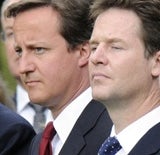General Election 2010: Did social media have an impact?
Toby Beresford, commercial director of Nudge Social Media, looks at the impact of social media on last week’s General Election.

Political marketing is a tricky affair. You have a single brand with thousands of politician “products”, each of varying quality. You can only sell once every five years, your price is half of someone’s income, and customers can only try your product if enough of their neighbours agree.
Yet, after all the campaigning, votes are largely cast based on long held beliefs, many quite deeply. Floating voters use manifestos and the media to make up their minds. When I was a local council candidate 12 years ago I knocked on every door in the ward. Sometimes the colour of my rosette alone was enough to have the door slammed in my face. But, my job wasn’t to persuade, have a cup of tea or even to discuss policies, it was simply to find the people who had already decided to vote for me.
On the election day itself I ran around, knocking on those same doors to “get out the vote.” It was a simple strategy and it worked. Our voters were the ones who showed on the day, we had a 13% swing towards us and it propelled me into local government for a single uneventful term of office.
Since my experience, the core door-to-door approach hasn’t changed but the media landscape has. New fragmented digital channels have emerged; thousands of emails now knock on thousands of virtual doors. Rich social media profiles provide ways to engage supporters and floating voters alike. A successful campaign has to use these new digital tools as part of the marketing mix.
The election winning Conservatives found their Facebook profile helped them “recruit, organise and motivate their supporters” as Jeremy Hunt, from the Shadow Cabinet [now Culture, Media, Sport and Olympics Secretary) remarked. Another party spokesman pointed out that social media had helped create a stronger link to supporters, with donations and party memberships increasing as a direct result.
But, in numerical terms, the Conservatives’ own social media campaign was overshadowed by the sheer volume of fake David Cameron posters (over half a million) that flooded the internet. Additionally 40,000 more people joined the “National Not Voting Conservative Day” Facebook group than the 100,000 that joined their Facebook “like-base”. Their own Facebook content, the ability to share fat chunks of the manifesto, was akin to a brand expecting users to passing on dull TV adverts or press releases to their friends.
So, did the parties miss a trick on social media? Of course, they all cover the basics and created a Facebook page, a Twitter account and a YouTube channel. Even Sarah Brown did her bit for her husband with her SarahBrown10 Twitter account. But all parties used these channels as if they were old media, bombarding voters with messages but not enabling any social interaction beyond simply allowing users to share party branded content.
This really was a missed opportunity: the voters were active on Facebook, as Richard Allan, Facebook Head of European policy confirms: “More than 260,000 users joined Democracy UK, Facebook’s political hub and nearly half a million people took part in our mock-election poll say who they wanted to be their PM. On May 6th nearly two million Facebook users (out of 26 million voters) clicked our ’I’ve Voted’ counter.”
Social content needs to be formatted to suit the user not the brand. Personally, I loved Facebook’s “Ministry of Mates” application which provided a fun way to say which of my friends I’d want in my imaginary cabinet, which I went on to share with all my friends, as did over 80,000 others. This was political discussion, social media style.
Yet despite the parties drab showing on social media, something did change in this election and that was the much commented on, death of the “uniform national swing”. London swung 2.5% to the Conservatives while in the North East the swing was nearly three times as much. Local swings in places such as Burnley, Redcar and even Westminster North created unlikely results.
Giving local issues prominence over national ones is something social media does very well. In particular Facebook’s home page prioritises news from friends over national news. For any marketer it is this same news stream that is becoming the hottest media property on the web. Facebook users spend over half their Facebook online time on this one page, reading the stream of news from their friends.
So for me, even if no single party managed to capitalise on social media in the way that Obama did, it still made its presence felt with these unpredicted local swings. As Venezuelan president, Hugo Chavez points out, social media is a “new weapon of the revolution” – it’s a pity our own political parties do not know how to fire it just yet.






